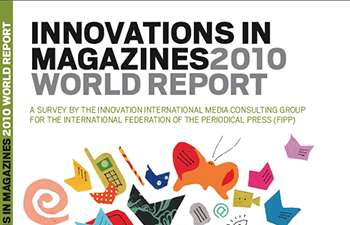Some magazine fans may feel like their favorite publications are dissolving into fragments of their former selves: fractured content distributed throughout the web, social media, digital editions and the surviving print versions.
But something unique to magazines does still hold at the center, and a new report on the future of magazines suggests that the future for both print and digital magazines will be strong.
The Innovations in Magazines 2010 World Report, prepared by Innovation Media Consulting in conjunction with the International Federation of the Periodical Press, was released March 1 and contains 100 pages of ideas gathered from around the world that could change the magazine industry.
Within the report are 30 short profiles of creative methods of making magazines fresh and new in an increasingly competitive media environment. The entire report can be purchased online in printed format for 100 euros or as a PDF for 75 euros.
For example, one chapter describes the integration of small video screens into the September 2009 print edition of Entertainment Weekly that played previews of CBS shows, engaging more of the reader’s senses in a “hybrid” medium. Another chapter details how magazines have developed online games that entice readers to engage with their brands in new ways. National Geographic’s game “Herod’s Lost Tomb” alone has been downloaded 15 million times.
FIPP, a London-based industry organization whose 800-plus members represent over 6,000 magazine titles, co-sponsored the report with Innovation, whose international group of researchers gathered creative approaches to magazine content, advertising and sales being tested around the world. The report mimics a similar yearly publication on new ideas in the newspaper business that Innovation has been creating for the last 11 years.
Finding Magazines’ Future
The co-editors of the report, Juan Señor and John Wilpers of Innovation Media Consulting, both come from traditional media backgrounds. Señor, a partner at Innovation, has worked for Wall Street Journal TV, CNBC Europe and the International Herald Tribune Television, and was nominated for an Emmy for his work as a reporter at PBS’ NewsHour. Wilpers, who is a consultant for Innovation, worked for a variety of U.S. newspapers and most recently has consulted with newsrooms including The Christian Science Monitor and the Los Angeles Times on the integration of blogging into their content.

Though the innovations contained in the report come from around the world, Señor notes that many “came from more innovative markets in Europe, London and New York — not accidentally, but coincidentally, because a lot of titles are in trouble” in those places.
Señor and Wilpers together formed their researchers’ collected ideas into a cohesive and provocative report on the remarkable variety of ways magazine publishers are experimenting with content, advertising and sales, both in digital and print forms.
“We asked publishers, what are you doing that other magazine publishers should know about? Really it was just doing the kind of research that a good reporter would do,” says Wilpers, who had a group of 25 freelance researchers working with him on the project. The focus of the report, according to Wilpers, was “initially supposed to be digital innovations, but print still drives so much of our revenue that we wanted to include that.”
Whether for digital or print, each innovation described in the report is individually fascinating. Perhaps more compelling, however, is the realization that taken together, these innovations will result in nothing less than the transformation of the magazine industry — and of the concept of the magazine itself.
Magazine Experimentation
Both Señor and Wilpers were impressed by magazine professionals’ willingness to experiment with new storytelling styles, platforms, formats and revenue streams.
“In the newspaper industry, for so long, we saw paralyzing fear,” says Wilpers. “And so people, out of fear, did nothing. They hoped that things would get better by going away.”
The magazine industry, though, has embraced digital formats and played with creative opportunities, without forgetting its print roots. “Digital is fun, it’s exciting, it’s sexy, and it’s one of the many answers to publishing going forward. But print’s going to be around for a while. We just need to figure out how to make it work,” Wilpers says.
That isn’t a clear-cut process. Today’s magazine transformation will never be complete, and shouldn’t be, says Señor.
“To be successful, you should be in a constant state of beta,” explains Señor. “If you’re not, it’s very difficult to move things forward.”
Aggregation and Curation
Magazines have experimented with both social media and user-generated content. Yet although magazines should engage with social media, Señor says, social media are “the platform, not the message.”
“Very few people out there are producing quality stuff,” he says. “For spot reporting, [social media are] fantastic, but still somebody has to quiet the noise and tell me what’s happening. There’s nothing like the role of a journalist to do the editing and selection for you.”
Señor and Wilpers believe this editing and selecting process will increasingly be the role of magazines in the future.
“You’ll see magazines like The Nation curating the best political content, even if they didn’t write it,” says Wilpers. He notes that a magazine’s reputation for quality carries over to other content editors choose for readers, and that as magazine staffs shrink, editors can selectively draw upon a wide variety of skilled outside authors and curate the best of their work for the magazine’s audience.
“There’s such a blog fog out there, so many people producing rubbish,” Señor says. “Just tell me what I should be listening to. Tell it to me with the independence and credibility of journalists. That’s the importance of an editor as a curator.”
The Magazine as ‘Content Proposition’
As magazines differentiate their content for multiple platforms, include a variety of content from their staff and other external sources, and use creative new approaches to their content, there is still a center that holds to define magazines.
Señor argues that today’s magazines each have their own “content propositions” that define their subjects and styles.
“The magazine doesn’t become a paper product, but a brand of journalism,” he says. “The magazine can still have a digital destination. It has a design. It has a masthead. It’s a brand proposition as opposed to a platform proposition, but it’s still doing a specific kind of storytelling.”
Each magazine expresses its content proposition in its own unique way, across multiple media and even through different business models.
“Every publication will have a quiver of opportunities, and no two quivers will be the same,” says Wilpers. “Everyone’s going to have lots and lots of different tools.”
Saving Paper
Paper can still be one of those tools. However, paper editions of magazines may no longer be a mass medium. Instead, they could become a special experience distinctive from what digital magazines provide.
Señor compares paper and digital editions to the levels of clothing in the fashion world. Today’s digital magazine editions, he says, are like the expensive, rare, high-end haute couture offered by fashion designers to generate public interest in their brands. Print editions are like the cheap, widespread, lower-status prêt-à-porter clothing they offer for a mass market. However, this analogy, Señor says, is about to be reversed.
“[Print] circulation is definitely going to go down, but if you make the magazine a quality product on paper, a premium product, you can charge much more. I see easily charging $10 for the paper version,” he says. “In time, the prêt-à-porter will become digital, and paper will become haute couture. But you have to make the paper experience have tremendous quality, not something you offer in other platforms.”
As magazines innovate, then, it’s not about leaving paper behind. It’s about experimenting with the best ways to gather a defined, branded set of content and to distribute it in the most fitting platform. Though all these simultaneous innovations may feel to observers like fragmentation and weakness, it may be the case that some essential quality of magazines will help them survive and even flourish through their transformation.
Susan Currie Sivek, Ph.D., is an assistant professor in the Mass Communication and Journalism Department at California State University, Fresno. Her research focuses on magazines and media communities. She also blogs at sivekmedia.com, and is the magazine correspondent for MediaShift.


The magazines that uphold their quality of content, and not fall into the “printed blog” trap, will survive.
I do not like to pick up a magazine and see layouts and articles, that remind me of a blog.